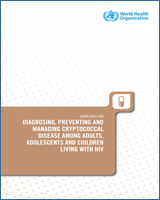The 2018 WHO recommendations for prevention and screening for cryptococcal disease remain unchanged (16).
2.2.2. Rationale for the recommendations
Since 2018, WHO guidelines have recommended that all adults and adolescents living with HIV who have a CD4 cell count <100 cells/mm3 be screened for cryptococcal antigen before ART initiation or reinitiation; cryptococcal antigen screening may also be considered for adults and adolescents living with HIV who have a CD4 cell count <200 cells/mm3. These recommendations were supported by evidence favouring the clinical benefit and cost–effectiveness of cryptococcal antigen screening (20,22,24–30). All individuals screening positive for cryptococcal antigen should be given pre-emptive antifungal therapy (fluconazole 800–1200 mg/day for adults and 12 mg/kg per day for adolescents for two weeks), followed by consolidation and maintenance fluconazole therapy, as for treatment. The 2019 guidelines from the Southern African HIV Clinicians Society recommend 1200 mg for first 2 weeks given safety and concerns over breakthrough infection (21).
Everyone testing positive for serum, plasma or whole-blood cryptococcal antigen during screening should be carefully evaluated for signs and symptoms of meningitis. Everyone with signs or symptoms of meningitis should have lumbar puncture and, where feasible, those without signs or symptoms of meningitis should also have lumbar puncture, with CSF examination and cryptococcal antigen assay (or India ink if cryptococcal antigen assay is not available) to exclude cryptococcal meningitis.
These recommendations would apply equally to people who present to care again after a period of disengagement from care with advanced HIV disease.
Cryptococcal antigen screening followed by pre-emptive therapy is preferred over providing fluconazole primary prophylaxis after considering cost, the potential for developing antifungal resistance and concerns about fetal safety among women of childbearing age without access to adequate contraception. Fluconazole primary prophylaxis should be made available in settings in which cryptococcal antigen screening is not available or there may be prolonged delays in receiving the result since cryptococcal disease and mortality peak in the first four weeks among people presenting with a CD4 cell count <100 cells/mm3 (31).
This recommendation is based on a systematic review that found a 70% reduction in mortality from cryptococcal disease among people living with HIV with low CD4 cell counts (95% confidence interval (CI) 12–89%); the review also found a 71% reduction in cryptococcal disease incidence; the incidence of serious adverse events did not differ, but some evidence indicated an increased risk of fluconazole-resistant Candida infection (23).
National guidelines should determine the optimal duration of prophylaxis based on available resources. Duration of fluconazole primary prophylaxis differed in the randomized trials that support the clinical benefit of this intervention. In the REALITY trial conducted in Kenya, Malawi, Uganda and Zimbabwe, fluconazole (100 mg once daily) was discontinued after 12 weeks (31). In another trial conducted in Uganda in the era of ART, fluconazole (200 mg three times per week) was discontinued when participants’ CD4 cell counts reached 200 cells/mm3 (32).
2.2.3. Recommendations for children
These recommendations apply to adults and adolescents with advanced HIV disease. The decision not to extend these recommendations to children was based on the recognition that cryptococcal disease in this age group is rare, even in countries with high incidence (4,10).

